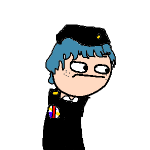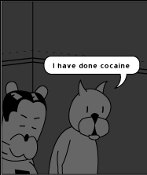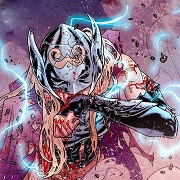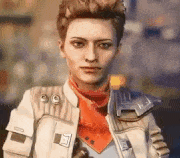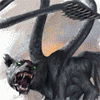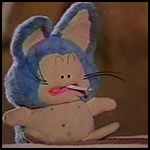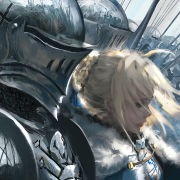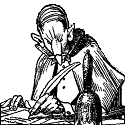|
So, is the cultist burning 4e books an admission that the OSR is a cult?
|
|
|
|

|
| # ? May 22, 2024 14:12 |
|
The redoutable gradenko_2000 hooked me up with these rules for randomly generating an hex map. and this is what I ended up with. Apologies in advance, the felt-tip pens were ancient and I can't color to save my life. I'm not sure what I'll end up doing with this (if anything), but it was a fun exercise. I know that those two temples at the southwest periodically mount expeditions south to clear the ruin near them of the undead infestation that keeps popping up there, and over time have turned it into a contest for which creed is better at skeleton bashing.
|
|
|
|
Run it in RC or something. Those rules look really similar to Ready Ref Sheets.
|
|
|
|
I'm planning on using the rules that was derived from (found here ) for an upcoming B/X or BECMI like hexcrawl campaign I'm probably starting in March or April. I'm a big sucker for procedural map generation.
|
|
|
|
Hmm... Something like that for an oceanic setting would be pretty useful for a campaign about pirates. Anyone know if there is one, or would I need to come up with something myself?
|
|
|
|
hectorgrey posted:Hmm... Something like that for an oceanic setting would be pretty useful for a campaign about pirates. Anyone know if there is one, or would I need to come up with something myself? There's ocean rules including islands in what I linked that would probably be a great base to use, but I think the encounter rules would need tweaked.
|
|
|
|
Does brown book OD&D have ability rules for fighting-men, or are they implied by the title 'hero' or something? I can't find anything in here that describes cleaving against monsters with less than 1 HD. Maybe that wasn't until a later version.
|
|
|
|
DalaranJ posted:Does brown book OD&D have ability rules for fighting-men, or are they implied by the title 'hero' or something? I can't find anything in here that describes cleaving against monsters with less than 1 HD. Maybe that wasn't until a later version. Man that version of cleave is freaking useless, how many enemies in this game even have less than 1 HD, ACKS still has the best cleave mechanics I'm aware of
|
|
|
|
Is there any Dark Sun primer coffee book like the one for Eberron in 3rd Edition D&D? I know that Eberron book is light on details and just drops the big plot hooks and basic assumptions, but that's all I use when running a setting, personally, and find the added detail of most setting books distracting.
|
|
|
|
drrockso20 posted:Man that version of cleave is freaking useless, how many enemies in this game even have less than 1 HD, ACKS still has the best cleave mechanics I'm aware of How do those go?
|
|
|
|
Any of you dorks going to Gary Con?
|
|
|
|
Traveller posted:How do those go? They go off whenever a combatant kills or incapacitates an opponent, also Monsters(who can cleave in ACKS), and Fighters(and other classes that use the fighter attack throw progression) may make a number of cleave attacks per round equal to their hit dice(and Fighter HD goes up every level till level 9 in ACKS so a high level Fighter is a beast in combat), while Clerics and Thieves(and other classes that use their progression), do it to half their hit dice, while Mages(and other classes that use their progression) can't cleave at all
|
|
|
|
Covok posted:Is there any Dark Sun primer coffee book like the one for Eberron in 3rd Edition D&D? I believe it was largely the box set and then supplements, each of the supplements focusing on a certain class or race. I wouldn't think the 4th edition books (two, I think, one with the main rules and one with monsters) offer enough info to be what you're looking for.
|
|
|
|
drrockso20 posted:They go off whenever a combatant kills or incapacitates an opponent, also Monsters(who can cleave in ACKS), and Fighters(and other classes that use the fighter attack throw progression) may make a number of cleave attacks per round equal to their hit dice(and Fighter HD goes up every level till level 9 in ACKS so a high level Fighter is a beast in combat), while Clerics and Thieves(and other classes that use their progression), do it to half their hit dice, while Mages(and other classes that use their progression) can't cleave at all Sounds yoinkable. Incidentally, what retroclones are out there with a Japanese/chanbara flavor? I know about Ruins and Ronin, but based off S&W Whitebox as it is it's a little too lacking in frill for me. I was thinking of hacking something together but I'd like to see if someone has done the work already.
|
|
|
|
drrockso20 posted:Man that version of cleave is freaking useless, how many enemies in this game even have less than 1 HD, ACKS still has the best cleave mechanics I'm aware of I agree that it's useless but how many times are you really going to get to cleave in a game where 90% of people's damage output is d6+0? I'm just trying to make sense of OD&Ds bizarre layout. As far as I can tell, the only special rule for fighters is that they get to levy taxes.
|
|
|
|
drrockso20 posted:Man that version of cleave is freaking useless, how many enemies in this game even have less than 1 HD, ACKS still has the best cleave mechanics I'm aware of The 1HD cleave makes a little more sense (although still not a ton) if you think of it like that most things in the world are 1HD. Goblins, orcs, bandits, enemy soldiers, etc make up the vast majority of nameless mooks you'll be fighting. The cleave mechanic gives you a sort of action hero cleaving through minions ability that nobody else in the game really gets. Thirty 1HD bandits is a legit option for a high level encounter in these games (in a way that it wouldn't be in, say, 3e or 4e), so if you're running into a lot of that or leading armies into battle or whatever it sort of makes sense. Except it really doesn't work in practice, and it creates this absurdly huge gap in power between 1HD and 2HD creatures that feels super weird and bad, so even if I get why it sort of makes sense in theory I still think it's a terrible idea. If I have any sort of cleave I generally just use the ACKS one these days.
|
|
|
|
DalaranJ posted:Does brown book OD&D have ability rules for fighting-men, or are they implied by the title 'hero' or something? I can't find anything in here that describes cleaving against monsters with less than 1 HD. Maybe that wasn't until a later version. The long answer: In The Strategic Review, Volume 1, No 2, Page 3, you get the following passages: quote:A super hero, for example, would attack eight times only if he were fighting normal men (or creatures basically that strength, i.e., kobolds, goblins, gnomes, dwarves, and so on). quote:Note that he is allowed one attack for each of his combat levels as the ratio of one Orc vs. the Hero is 1:4, so this is treated as normal (non-fantastic) melee, as is any combat where the score of one side is a base 1 hit die or less. Cross-referencing this with the level titles in Book 1 - Men & Magic, page 16, a "Superhero" is indeed a level 8 Fighting Man and a "Hero" is a level 4 Fighting Man. Note that this is slightly different from the rule in AD&D 1st Edition, Player's Handbook, page 25: quote:Note: This excludes melee combat with monsters (q.v.) of less than one hit die (d8 and non-exceptional (0 level) humans and semi-humans, i.e. all creatures with less than one eight-sided hit die. All of these creatures entitle a fighter to attack once for each of his or her experience levels (See COMBAT). An AD&D Orc has exactly one "normal" 1d8 hit die, so the Fighter would not be able to use its multi-attack rule against them. The rule was originally derived from Chainmail. In page 30, the Hero and Superhero units are defined as: quote:HEROES (and Anti-heroes): Included in this class are certain well-known knights, leaders of army contingents, and similar men. They have the fighting ability of four figures, the class being dependent on the arms and equipment of the Hero types themselves, who can range from Light Foot to Heavy Horse. Heroes (and Anti-heroes) need never check morale, and they add 1 to the die or dice of their unit (or whatever unit they are with). They are the last figure in a unit that will be killed by regular missile fire of melee, but they may be attacked individually by enemy troops of like type (such as other Hero-types) or creatures shown on the Fantasy Combat Table. Heroes (and Anti-heroes) may act independent of their command in order to combat some other fantastic character. When meleed by regular troops, and combat takes place on the non-Fantasy Combat Tables, four simultaneous kills must be scored against Heroes (or Anti-heroes) to eliminate them. Otherwise, there is no effect upon them. The "have the fighting ability of four figures" was reinterpreted to mean that they attack as many times as four men do, if the combat is against "non-fantastic" combatants. And then the Superhero is twice as powerful as a Hero, so the Superhero can attack up to three times. So while it wouldn't have shown up in the books specifically, the fact that OD&D without Greyhawk calls out using Chainmail for its rules implies that some, if not most people playing OD&D back in the day would be familiar with the capabilities of a Hero/Superhero and would translate it into D&D as well. It gets somewhat more complicated. In Book 2 - Monsters and Treasure, page 5, you get the following passage: quote:Attack/Defense capabilities versus normal men are simply a matter of allowing one roll as a man-type for every hit die, with any bonuses being given to only one of the attacks, i.e. a Troll would attack six times, once with a +3 added to the die roll. (Combat is detailed in Vol. III.) A "normal man", of course, is a creature with just one hit die, so an attacker with more than 1 HD would be able to attack multiple times against 1-HD-or-less targets, up to the limit of the attacker's hit dice. Except this is a generic prescription for combat, so it doesn't apply to Fighting Men specifically so much as it applies to everyone. A level 3 Magic-User, a Conjurer, has 2 HD and has the Fighting Capability of 2 Men, so under this rule they'd be able to attack twice when fighting 1-HD-or-less targets, too! Ditto a level 3 Cleric, a Village Priest. That said, this might not be out-of-place, because if we go back to Chainmail again, the definition of a Wizard on page 30 says: quote:WIZARDS (including Sorcerers at -1, Warlocks at -2, Magicians at -3, Seers at -4). In normal combat, all this class will fight as two Armored Foot So high-level spellcasters themselves are capable of fighting as multiple normal men when fighting against normal men, except at a reduced rate compared to Fighting Men/Heroes. And to tie this back to the current discussion, it then makes some sort of passed-down historical sense that Clerics and Thieves, as "lesser Fighters", can still make cleave attacks per drrockso20's description of combat in ACKS drrockso20 posted:Man that version of cleave is freaking useless, how many enemies in this game even have less than 1 HD, ACKS still has the best cleave mechanics I'm aware of Alternatively, when Kobolds come up while rolling randomly for monsters and need to roll (4d4 x 100) for their Number Appearing.
|
|
|
|
So far my favorite line from the books is "Example of Bandits: Assume 183 bandits are encountered." But there are so many good contenders. OD&D is so delightfully bizarre compared to our current gaming sensibilities.
|
|
|
|
I wrote up my earlier post on using percentile dice in D&D to include saving throw tables. I'll be looking to expand this out to B/X/Rules Cyclopedia and AD&D, as the progressions are quite similar.
|
|
|
|
The version of Cleave I used in TAAC was based on HP rather than HD: if you inflict more damage than it takes to kill your target, then any excess HP are passed on to the next enemy in line. And if they die, the next. And the next... It was a fighter-only ability, but it was automatic and limitless, so you could take out a large number of trash enemies in a single attack, and keep doing it all day! Because that's what fighters are trained to do.
|
|
|
|
Payndz posted:The version of Cleave I used in TAAC was based on HP rather than HD: if you inflict more damage than it takes to kill your target, then any excess HP are passed on to the next enemy in line. And if they die, the next. And the next... It was a fighter-only ability, but it was automatic and limitless, so you could take out a large number of trash enemies in a single attack, and keep doing it all day! Because that's what fighters are trained to do. Oh yeah, I remember that - the Fighter player loved it, his record was a dozen goblins killed in a single blow, followed by a Battle Cry to force a morale check, which sent the rest of the warcamp fleeing.
|
|
|
|
Would be funny to stat up a DCC monster with a Cleave ability that just cuts through a half-dozen level 0s..
|
|
|
|
Trust me, as someone who's funneled, monsters don't need Cleave to do that.
|
|
|
|
I'm still a bit confused about OD&D combat works since I don't have access to chainmail. Does the fighter basically get 1 attack per level? How many attacks does a 'hero' or 'superhero' get? How many attacks does a 'wizard' get? How does 20 to 20 combat work? How does 20 to 1 combat work? DalaranJ fucked around with this message at 03:12 on Mar 5, 2016 |
|
|
|
Basic Rule: If the target has more than one hit die, the Fighter (and any other creature) can only attack (it) once per round, at any level, no matter what Additional attacks based on hit dice: The Fighter can attack once per hit die, if their target only has 1 hit die or less. Alternate interpretations of additional attacks: A. Any player-character can attack once per hit die, if their target only has 1 hit die or less. Fighters still have an advantage since they'll have more hit dice, and therefore more attacks, than Clerics, MUs and Thieves B. Any creature, period, can attack once per hit die, if their target only has 1 hit die or less, meaning including monsters. This shouldn't really come up unless you have NPCs on the side of the PCs, since the PCs will be exempt from this rule rather quickly (and you should probably refrain from throwing 2+ HD monsters at level 1 PCs) Examples: A Warrior, or a level 2 Fighter, can attack twice per round if they're fighting creatures of 1 HD or less, because Warriors have 2 hit dice A Hero, or a level 4 Fighter, can attack four times per round if they're fighting creatures of 1 HD or less, because Heroes have 4 hit dice A Super Hero, or a level 8 Fighter, can attack eight times per round if they're fighting creatures of 1 HD or less, because Super Heroes have 8 hit dice If you implement alternate interpretation A, then a Wizard, or a level 11 Magic-User, can attack eight times per round if they're fighting creatures of 1 HD or less, because Wizards have 8 hit dice Additional attacks based on the Man / Hero / Super Hero titles in the Fighting Capability column: 1. If your Fighting Capability is Man, then you can attack once per round if you're fighting creatures of 1 HD or less 2. If your Fighting Capability is 2 Men, then you can attack twice per round if you're fighting creatures of 1 HD or less 3. If your Fighting Capability is 3 Men, then you can attack thrice per round if you're fighting creatures of 1 HD or less 4. If your Fighting Capability is Hero, then you can attack four times per round if you're fighting creatures of 1 HD or less 5. If your Fighting Capability is Super Hero, then you can attack eight times per round if you're fighting creatures of 1 HD or less 6. If your Fighting Capability is Wizard, then you can attack two times per round if you're fighting creatures of 1 HD or less This caps the number of attacks per round eight, instead of letting it scale to 9+ such as when Fighters become Lords at level 9. This also slows down the progression of a Wizard and a Cleric's attacks. Note 1: The Swashbuckler, or a level 5 Fighter, has a Fighting Capability of "Hero, or 5 Men". Up to you if you think this means they should get five attacks per round if they're fighting creatures of 1 HD or less. Same with the Myrmidon, or a level 6 Fighter. Note 2: This interpretation means that a Magic-User of level 7, 8 and 9 (Enchanter, Warlock, Sorcerer), will have four attacks per round if they're fighting creatures of 1 HD or less, since their Fighting Capability is classified as Hero, but then upon hitting level 10 (Necromancer), they will drop to two attacks per round if they're fighting creatures of 1 HD or less, because their Fighting Capability changes to Wizard. Up to you if you want to adjust/correct for this possible oddity. gradenko_2000 fucked around with this message at 03:34 on Mar 5, 2016 |
|
|
|
gradenko_2000 posted:Any creature, period, can attack once per hit die, if their target only has 1 hit die or less, meaning including monsters. This shouldn't really come up unless you have NPCs on the side of the PCs, since the PCs will be exempt from this rule rather quickly (and you should probably refrain from throwing 2+ HD monsters at level 1 PCs) Oh, that's why it said the troll can attack six times against 'normal men'. Normal men meant NPCs that have 1 HD. Edit: Okay, so here's what I'll probably do for army battles. Roll against AC as normal. Hit Dice are the new HP. (So a 'normal man' dies when hit in army combat) 20 men deal d6 HD damage. 10 or fewer men deal d3 HD damage. 1 creature gets all it's attacks against 20 men and deals 1 HD for each hit. 1 (multiHD) creature hiding/leading in a group of twenty men loses it's multiple attacks and instead adds 2 damage to a hit. A multiHD creature hiding/leading can't be singled out for damage by a group. (But PCs and creatures can single each other out for normal combat.) Some types of units gain attack bonuses in certain circumstances. (Calvary flanks, archery vs flying) I'll probably come up with some other leadership bonus for the fighting man too. DalaranJ fucked around with this message at 03:40 on Mar 5, 2016 |
|
|
|
DalaranJ posted:Oh, that's why it said the troll can attack six times against 'normal men'. Normal men meant NPCs that have 1 HD. Yes. Also, I cleaned up my post further to account for other ways to rule this.
|
|
|
|
gradenko_2000 posted:Note 2: This interpretation means that a Magic-User of level 7, 8 and 9 (Enchanter, Warlock, Sorcerer), will have four attacks per round if they're fighting creatures of 1 HD or less, since their Fighting Capability is classified as Hero, but then upon hitting level 10 (Necromancer), they will drop to two attacks per round if they're fighting creatures of 1 HD or less, because their Fighting Capability changes to Wizard. Up to you if you want to adjust/correct for this possible oddity. Clearly, the powerful magic the wizard has mastered has taken it's toll on their body.
|
|
|
|
I've got a whole bunch of my old D&D stuff listed for sale here http://forums.somethingawful.com/showthread.php?threadid=3768056 Including Tegel Manor and a lot of the GAZ series.
|
|
|
|
So is there a specific 4e thread anymore, or is this the place to bother folks? I had a couple friends who were curious about 4e after we had some confusing conversations about their pathfinder game and I was wondering if there was a decent lowish level and short thing for new-to-the-system folks I could run them through. I was thinking making them like level 5 to get some powers to play with and so on, but I admittedly haven't Dm'd d&d 4e.
|
|
|
|
There's still a 4E thread in which you might want to ask the same question, it was just slightly buried. If you can provide a little more detail on your conversation with your friends about Pathfinder – such as anything they specifically didn't like or were having issues with or looking for or whatnot – you might get better recommendations in the responses you receive.
|
|
|
|
Auralsaurus Flex posted:There's still a 4E thread in which you might want to ask the same question, it was just slightly buried. Huh, I dunno how I missed it going back several pages. I'll shoot it over there then. Thanks!
|
|
|
|
Honestly, I'd be very tempted to start them at level 1 - for one thing, level 1 in 4e is similar to around level 4-5 in Pathfinder when it comes to power level, and for another, it means that they can get used to the mechanics without being overwhelmed by choices (remember that pathfinder doesn't give characters that many choices to work with early on; especially when it comes to the non-casting classes). It may also be worth having a session 0 to point out some mechanical differences - in particular, how encounter/daily power limitations are intended to be narrative (that is, your fighter can use his daily power more than once per day, he just doesn't; either the IC situation isn't exactly right, or it just doesn't come to mind) rather than literal (that is, your fighter is literally incapable of pulling off this particular move more than once per day). That particular distinction (and the fact that it was intentional) was never explained to me until very recently, and that made playing non-casting classes seem somewhat ridiculous. Session 0 would also be a good place to do character generation - once you know what kinds of characters the players want to play, you can actually give them shorter lists of powers to choose from based on which would be useful for the kind of character they want to play. This again would help reduce the problem 4e had when it came to overwhelming beginners with choices - especially if you include options from the Power books (which may be worth doing; at least with Martial Power).
|
|
|
|
hectorgrey posted:It may also be worth having a session 0 to point out some mechanical differences - in particular, how encounter/daily power limitations are intended to be narrative (that is, your fighter can use his daily power more than once per day, he just doesn't; either the IC situation isn't exactly right, or it just doesn't come to mind) rather than literal (that is, your fighter is literally incapable of pulling off this particular move more than once per day). That particular distinction (and the fact that it was intentional) was never explained to me until very recently, and that made playing non-casting classes seem somewhat ridiculous. This distinction is really a matter of preference than being one or the other. but i find weird that people cant find it believable that there's a maneuver that you only have the strength for once a day.
|
|
|
|
Elfgames posted:This distinction is really a matter of preference than being one or the other. but i find weird that people cant find it believable that there's a maneuver that you only have the strength for once a day. Another way of looking at it is that when a player uses a power, they are literally declaring that the narrative at that particular instant is such that their character can accomplish the feat. Setting aside how it's described for one moment (and really, don't pretend that you're so hung up on semantics that an entire game is rendered unplayable), anyone who complains that it's "not realistic" that a power can only be used once a day has never tried to make two toe-hits in the same 5-point sport fencing bout.
|
|
|
|
Elfgames posted:This distinction is really a matter of preference than being one or the other. but i find weird that people cant find it believable that there's a maneuver that you only have the strength for once a day. That to me is literally unbelievable (especially when it comes to powers that basically boil down to "hit him a little harder than normal") - if you can do a physical action once per day, then you should be able to do it repeatedly. If it's so exhausting that you can only do it once per day, then it should pretty much leave you unable to fight at all. Keeping it narrative (which, as mentioned, was the intent) also works with the 4e style multiclassing - your character doesn't just forget how to do whatever power they lost in exchange for the new one; it just isn't as important to their character in narrative terms as the new ability that they gained. If one takes the encounter/daily limitations as literally "your character is only physically capable of doing this thing once per fight/day", then the Essentials fighter makes far more sense than the PHB one. As for the fencing analogy, it might not be possible to do it twice in the same sport fencing bout, but do you only fight one bout per day? If you fight a second bout, are you no longer capable of pulling off a toe hit, regardless of whether the second person witnessed your first bout? See above regarding the Essentials fighter, and the fact that they have encounter powers but not daily.
|
|
|
|
I personally don't put much stock into debating the "believability" of a character's attacks any more than I question why the Warrior can't use Colossus Smash back-to-back-to-back
|
|
|
|
I don't so much care about how believable the attack is - by the point the attacks really get silly, characters are taking on elder dragons by the handful, and that part of the game is supposed to feel insane and awesome. It's just that "I can only do this once per day" needs more explanation than "because it says so in this book". If the once per day limitation is in character, then there should be an in character explanation for that somewhere. Also, if I played D&D the same way I would play WoW, then I would agree completely with believable mechanics making absolutely no difference. At that point, however, one is deciding to play the game as simply a board game with a slightly larger variety of potential boards...
|
|
|
|
I suppose one way to look at it would be that if it's standard practice to impose a penalty on a character declaring a more special type of attack (whether or not there's an ability/feat/class feature to make that special attack eventually standardized and unpenalized), then the Encounter/Daily framework is the temporal equivalent of a player going "called shot to the head!" and you making them take a -2 to the roll in exchange for a greater effect when it hits.
|
|
|
|

|
| # ? May 22, 2024 14:12 |
|
All combat in D&D is abstracted to lesser or greater levels. Rounds and attack rolls and hit points in basic D&D are an abstraction of a complex melee - your character isn't actually deciding 'i will make an attempt to injure my opponent, they are an ogre and I have zero chance of killing them but I will try and reduce their hit points' - the division into rounds is just an arbitrary way of managing conflict. In-character you're trying to find an opening to stab it to death while not being hurt yourself, or injure it to slow it down and prevent it injuring you seriously. A 50 hp fighter isn't actually being stabbed repeatedly when they're hit 10 times - we just describe the early hits as glances or bruises or narrow escapes, and the last hit as the lethal ones. 4e dailies are abstractions too, they're just designed backwards - the game is designed from the standpoint that the desired result of a fight is that people don't do their best move over and over, because in real life and the inspirational fiction people don't do their best move over and over. So let's design the combat abstraction to match that. There are a bunch of ways that you could implement this to prevent the same sweet move being used over and over: * neat moves cost increasing resources each time you use them * you need to chain multiple moves together before you can do your neat move * you can't use your neat move until late in the fight (13th Age does some of this) * you can only use your neat move if a random element says you can (13th Age also does this with fighter stuff) * you can only use your neat move when a complex subsystem says that you can (you could imagine a highly detailed system for tracking melee with openings and footwork and bluffing and positioning, and then neat moves on your sheet that only work when you've moved the enemy into the correct position or when the enemy cocks up and allows you or when you feint lower-left and the sun is at the right angle) * let the player pick when their neat move works, and backfill the fiction to match that (4e's approach) It's very practical in play. Go from result to fiction, rather than fiction to result. We do exactly the same anytime we look at 5 damage on the dice and decide whether that's a mortal wound on a kobold or a slightly irritated dragon.
|
|
|




